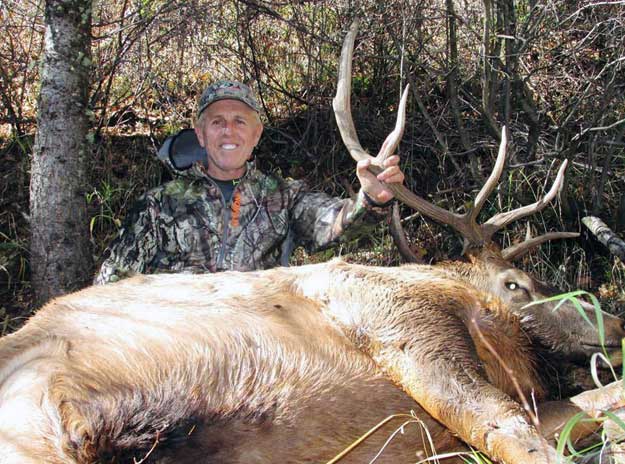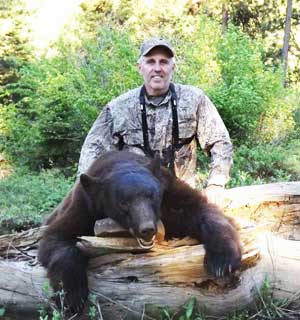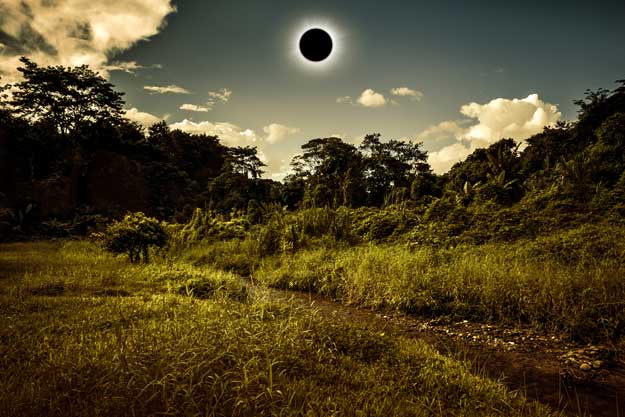By: Parrey Cremeans

The private land that we’ll be hunting on in New Mexico with Mossy Oak is about 6,000 to 7,000 acres. We saw several elk on this property last year that would score 325 to 350 on Pope and Young, so we know there are some good bulls available for harvest in 2017. A bull that will score 340 to 350 is a trophy bull anywhere you hunt for elk. The property on this hunt is bowhunting, and I’m often asked, “How close do the elk come to the bowhunters you guide?” The most difficult part of elk hunting is first finding the elk and then locating elk that haven’t had a great deal of hunting pressure.
My favorite thing about elk hunting is calling the elk in to a bowhunter. There’s nothing quite like hearing an 800-pound animal screaming out a bugle as he’s coming to you, thinking you’re another bull elk trying to steal cows from his herd. Most of the time the bull elk coming in already has determined he will beat you up if he finds you. But seeing or hearing my hunter place an arrow in a monster bull that’s only 8 - 10 yards from the hunter is so exciting.
Turn your volume down as you watch this screaming elk bugle video:
The elk we’ll be hunting in New Mexico should be bugling when we arrive, which makes for a great hunt. We had one elk last year that a hunter took at nine yards with his bow, and we had another elk come in to us close. However, then our hunter missed the bull elk when he stepped in an opening at about 25 yards. Most of the shots that our hunters will take will be at 30 yards or less.
When I know that we have an elk coming in, I’ll put my hunter in a place where I think he can get a shot at that bull. Then, I get behind my hunter and begin calling. I like to be where I can see the hunter and hear the bull. However, if the bull veers off to his left or right, I want to make sure I’m out of sight of the hunter. If the bull’s going to pass on the hunter’s left, I’ll try to call as I walk to my hunter’s right. Most of the time I can pull that bull right in front of my hunter. So, I always try and reach a place where I can move without the bull seeing, hearing or smelling me. Then I can work that bull to within bow range of my hunter.
Hunting elk is much like hunting wild turkeys. Often you can make one single call, and the bull knows exactly where you are and come straight to you. If that bull is coming straight to my hunter, I won’t move at all and probably won't call very much. But if I have to move my position to pull that bull in to my hunter, I don’t hesitate to move. We need to remember that elk move a lot. By calling from various places, I think I sound more like an elk that’s moving.
 I will probably head to Oregon after my Mossy Oak elk hunt because Oregon has some late season blacktail deer hunting with a bow. Or I may go straight back to California after my hunt with Mossy Oak to hunt there. Many people don’t understand how many bears we have to hunt here in California, but I’ll put our black bear hunting against any state in the U.S. and every province in Canada for bear density. There are several reasons why California has outstanding black bear hunting. One, there is a tremendous amount of forest land owned by large timber companies, so California has a huge amount of habitat for bears when you include the state’s national forest lands.
I will probably head to Oregon after my Mossy Oak elk hunt because Oregon has some late season blacktail deer hunting with a bow. Or I may go straight back to California after my hunt with Mossy Oak to hunt there. Many people don’t understand how many bears we have to hunt here in California, but I’ll put our black bear hunting against any state in the U.S. and every province in Canada for bear density. There are several reasons why California has outstanding black bear hunting. One, there is a tremendous amount of forest land owned by large timber companies, so California has a huge amount of habitat for bears when you include the state’s national forest lands.
Five or six years ago the state took away our opportunity to bear hunt with hounds. When we could hunt bears with hounds, California had a quota where hunters took 1800 bears per year - the number of bears California’s Department of Fish and Wildlife said hunters needed to harvest to control bear numbers in the state. However, the State has lowered the quota of bears hunters can take down to 900.
Let’s say that of that 800-900 bears that no longer can be harvested by hunters that probably 600 of those bears are sows. If each sow has two cubs a year that means about 1200 new bears each year. Then you easily can understand why so many black bears live in California. California has all color phases of black bears, including brown, cinnamon and blonde bears. We also take some really big bears here in California - 400 to 500 pounders on some of the ranches we hunt.
Another problem we have is you can't use any type of attractant or bait to hunt any species of game in California. But since we hunt in the mountains and the wilderness areas for deer, and luckily the bear season is open during the same time, when our hunters go into these wilderness and mountainous areas to spot and stalk blacktail deer, in a day of hunting they may see five or six bucks and often eight or 10 bears. Our hunters often have to decide whether they want to go after bear those days or continue to hunt for buck blacktails. Our true season for bucks and bears begins the third week of August and continues to the second week of September. Then there is a week break, and gun season for both species begins and often runs until the end of December. Perhaps you may get two tags for an early season hunt in California, one for a deer and the other for a bear.
Don’t forget, these hunts will take place in August or September when the weather’s very hot. For that reason, many of our hunts are horseback hunts. That way we can get a deer or a bear that’s harvested by a hunter field dressed and quartered and back to a cooler before the meat spoils. Our hunters usually will choose to hunt either deer or bear, but if they buy an extra tag, they can take both a deer and a bear. So even though most hunters probably never consider hunting bear in August or taking a bear and/or a deer in August, they can do both in California at this time of the year.
California homes a number of wilderness areas, and all of those wilderness areas have good numbers of big bear. If you’re are looking for the opportunity to go on some early-season bowhunts, check out the opportunities offered in the State of California,and you may be surprised to know that you still have time to take a hunt for black bear or blacktail deer right now.
Part 4: Elk and Mule Deer in Texas, New Mexico and Old Mexico




























